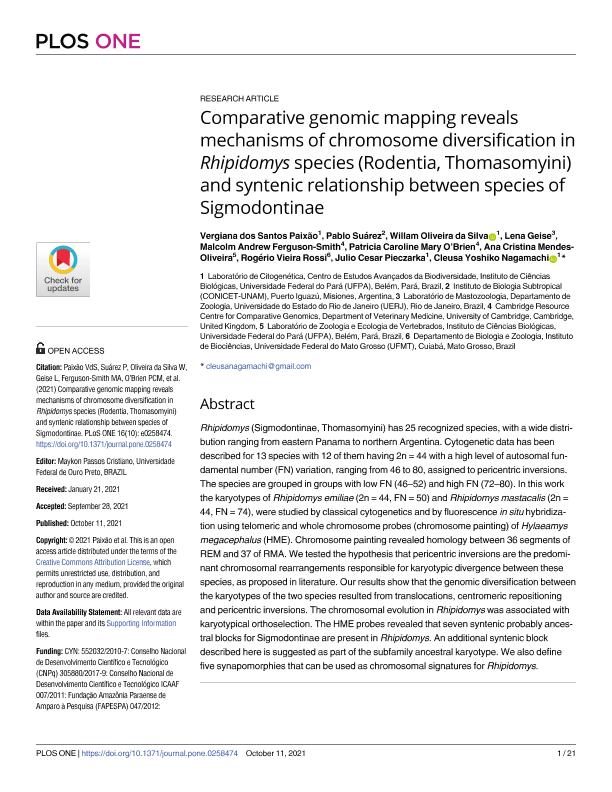Artículo
Comparative genomic mapping reveals mechanisms of chromosome diversification in Rhipidomys species (Rodentia, Thomasomyini) and syntenic relationship between species of Sigmodontinae
Dos Santos Paixão, Vergiana; Suarez, Pablo ; Oliveira da Silva, Willam; Geise, Lena; Ferguson Smith, Malcolm Andrew; Mary O’Brien, Patricia Caroline; Mendes Oliveira, Ana Cristina; Vieira Rossi, Rogério; Pieczarka, Julio Cesar; Nagamachi, Cleusa Yoshiko
; Oliveira da Silva, Willam; Geise, Lena; Ferguson Smith, Malcolm Andrew; Mary O’Brien, Patricia Caroline; Mendes Oliveira, Ana Cristina; Vieira Rossi, Rogério; Pieczarka, Julio Cesar; Nagamachi, Cleusa Yoshiko
 ; Oliveira da Silva, Willam; Geise, Lena; Ferguson Smith, Malcolm Andrew; Mary O’Brien, Patricia Caroline; Mendes Oliveira, Ana Cristina; Vieira Rossi, Rogério; Pieczarka, Julio Cesar; Nagamachi, Cleusa Yoshiko
; Oliveira da Silva, Willam; Geise, Lena; Ferguson Smith, Malcolm Andrew; Mary O’Brien, Patricia Caroline; Mendes Oliveira, Ana Cristina; Vieira Rossi, Rogério; Pieczarka, Julio Cesar; Nagamachi, Cleusa Yoshiko
Fecha de publicación:
10/2021
Editorial:
Public Library of Science
Revista:
Plos One
ISSN:
1932-6203
Idioma:
Inglés
Tipo de recurso:
Artículo publicado
Clasificación temática:
Resumen
Rhipidomys (Sigmodontinae, Thomasomyini) has 25 recognized species, with a wide distribution ranging from eastern Panama to northern Argentina. Cytogenetic data has been described for 13 species with 12 of them having 2n = 44 with a high level of autosomal fundamental number (FN) variation, ranging from 46 to 80, assigned to pericentric inversions. The species are grouped in groups with low FN (46-52) and high FN (72-80). In this work the karyotypes of Rhipidomys emiliae (2n = 44, FN = 50) and Rhipidomys mastacalis (2n = 44, FN = 74), were studied by classical cytogenetics and by fluorescence in situ hybridization using telomeric and whole chromosome probes (chromosome painting) of Hylaeamys megacephalus (HME). Chromosome painting revealed homology between 36 segments of REM and 37 of RMA. We tested the hypothesis that pericentric inversions are the predominant chromosomal rearrangements responsible for karyotypic divergence between these species, as proposed in literature. Our results show that the genomic diversification between the karyotypes of the two species resulted from translocations, centromeric repositioning and pericentric inversions. The chromosomal evolution in Rhipidomys was associatedwith karyotypical orthoselection. The HME probes revealed that seven syntenic probably ancestral blocks for Sigmodontinae are present in Rhipidomys. An additional syntenic block described here is suggested as part of the subfamily ancestral karyotype. We also define five synapomorphies that can be used as chromosomal signatures for Rhipidomys.
Archivos asociados
Licencia
Identificadores
Colecciones
Articulos(IBS)
Articulos de INSTITUTO DE BIOLOGIA SUBTROPICAL
Articulos de INSTITUTO DE BIOLOGIA SUBTROPICAL
Citación
Dos Santos Paixão, Vergiana; Suarez, Pablo; Oliveira da Silva, Willam; Geise, Lena ; Ferguson Smith, Malcolm Andrew; et al.; Comparative genomic mapping reveals mechanisms of chromosome diversification in Rhipidomys species (Rodentia, Thomasomyini) and syntenic relationship between species of Sigmodontinae; Public Library of Science; Plos One; 10-2021; 1-21
Compartir
Altmétricas



